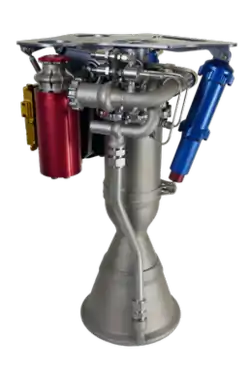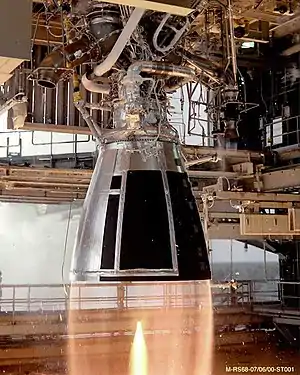 Sea-level Rutherford engine | |
| Country of origin | United States New Zealand |
|---|---|
| Designer | Rocket Lab |
| Manufacturer | Rocket Lab |
| Application | First- and second-stage engine |
| Status | Active |
| Liquid-fuel engine | |
| Propellant | LOX[1] / RP-1[1] |
| Cycle | Electric pump-fed engine |
| Pumps | 2 electric pumps |
| Configuration | |
| Chamber | 1 |
| Performance | |
| Thrust, vacuum | |
| Thrust, sea-level |
|
| Thrust-to-weight ratio | 72.8 |
| Specific impulse, vacuum | 343 s (3.36 km/s)[2][1] |
| Specific impulse, sea-level | 311 s (3.05 km/s)[2][1] |
| Dimensions | |
| Diameter | 25 cm (9.8 in) |
| Dry weight | 35 kg (77 lb)[3] |
| Used in | |
| Electron, HASTE | |
| References | |
| References | [4][5][6][7] |
Rutherford is a liquid-propellant rocket engine designed by aerospace company Rocket Lab[8] and manufactured in Long Beach, California.[9] The engine is used on the company's own rocket, Electron. It uses LOX (liquid oxygen) and RP-1 (refined kerosene) as its propellants and is the first flight-ready engine to use the electric-pump feed cycle. The rocket uses a similar engine arrangement to the Falcon 9; a two-stage rocket using a cluster of nine identical engines on the first stage, and one vacuum-optimized version with a longer nozzle on the second stage. This arrangement is also known as an octaweb.[10][6][7] The sea-level version produces 24.9 kN (5,600 lbf) of thrust and has a specific impulse of 311 s (3.05 km/s), while the vacuum optimized-version produces 25.8 kN (5,800 lbf) of thrust and has a specific impulse of 343 s (3.36 km/s).[11]
First test-firing took place in 2013.[12] The engine was qualified for flight in March 2016[13] and had its first flight on 25 May 2017.[14] As of August 2023, the engine has powered 40 Electron flights in total, making the count of flown engines 399, including one engine flown twice.[15]
Description
Rutherford is named after renowned New Zealand-born scientist Ernest Rutherford. It is a small liquid-propellant rocket engine designed to be simple and cheap to produce. It is used as both a first-stage and a second-stage engine, which simplifies logistics and improves economies of scale.[6][7] To reduce its cost, it uses the electric-pump feed cycle, being the first flight-ready engine of such type.[5] It is fabricated largely by 3D printing, using a method called laser powder bed fusion, and more specifically Direct Metal Laser Solidification (DMLS®). Its combustion chamber, injectors, pumps, and main propellant valves are all 3D-printed.[16][17][18]
As with all pump-fed engines, the Rutherford uses a rotodynamic pump to increase the pressure from the tanks to that needed by the combustion chamber.[5] The use of a pump avoids the need for heavy tanks capable of holding high pressures and the high amounts of inert gas needed to keep the tanks pressurized during flight.[19]
The pumps (one for the fuel and one for the oxidizer) in electric-pump feed engines are driven by an electric motor.[19] The Rutherford engine uses dual brushless DC electric motors and a lithium polymer battery. It is claimed that this improves efficiency from the 50% of a typical gas-generator cycle to 95%.[20] However, the battery pack increases the weight of the complete engine and presents an energy conversion issue.[19]
Each engine has two small motors that generate 37 kW (50 hp) while spinning at 40 000 rpm.[20] The first-stage battery, which has to power the pumps of nine engines simultaneously, can provide over 1 MW (1,300 hp) of electric power.[21]
The engine is regeneratively cooled, meaning that before injection some of the cold RP-1 is passed through cooling channels embedded in the combustion chamber and nozzle structure, transferring heat away from them, before finally being injected into the combustion chamber.
See also
References
- 1 2 3 4 "Electron". Rocket Lab. Retrieved 24 July 2017.
- 1 2 3 "rocket lab reach 500 rutherford engine test fires".
- 1 2 3 "Rocket Lab Increases Electron Payload Capacity, Enabling Interplanetary Missions and Reusability". Rocket Lab. Retrieved 6 August 2020.
- ↑ Brügge, Norbert (11 July 2016). "Asian space-rocket liquid-propellant engines". B14643.de. Retrieved 20 September 2016.
- 1 2 3 "Propulsion". Rocket Lab. Archived from the original on 19 September 2016. Retrieved 19 September 2016.
- 1 2 3 Brügge, Norbert. "Electron NLV". B14643.de. Archived from the original on 27 September 2016. Retrieved 20 September 2016.
- 1 2 3 Brügge, Norbert. "Electron Propulsion". B14643.de. Archived from the original on 27 September 2016. Retrieved 20 September 2016.
- ↑ "Rocket Lab Reveals First Battery-Powered Rocket for Commercial Launches to Space | Rocket Lab". Rocket Lab. Retrieved 25 May 2017.
- ↑ Knapp, Alex (21 May 2017). "Rocket Lab Becomes A Space Unicorn With A $75 Million Funding Round". Forbes. Retrieved 25 May 2017.
- ↑ "Meet the Octaweb – SpaceX". blogs.nasa.gov. Retrieved 18 September 2020.
- ↑ "Electron". Rocket Lab. Archived from the original on 7 May 2021. Retrieved 1 February 2018.
- ↑ "10 things about Rocket Lab". 27 May 2017. Archived from the original on 21 May 2021. Retrieved 25 November 2019.
- ↑ "Rutherford Engine Qualified for Flight". Rocket Lab. March 2016. Archived from the original on 25 April 2016. Retrieved 19 September 2016.
- ↑ "New Zealand space launch is first from a private site". BBC News. 25 May 2017. Retrieved 25 May 2017.
- ↑ @RocketLab (24 August 2023). "260 399 Rutherford engines launched to space" (Tweet) – via Twitter.
- ↑ Bradley, Grant (15 April 2015). "Rocket Lab unveils world's first battery rocket engine". The New Zealand Herald. Retrieved 20 September 2016.
- ↑ Grush, Loren (15 April 2015). "A 3D-Printed, Battery-Powered Rocket Engine". Popular Science. Archived from the original on 31 January 2016. Retrieved 20 September 2016.
- ↑ "Propulsion". Rocket Lab. Archived from the original on 10 September 2015. Retrieved 19 September 2016.
- 1 2 3 Rachov, Pablo; Tacca, Hernán; Lentini, Diego (2013). "Electric Feed Systems for Liquid-Propellant Rockets" (PDF). Journal of Propulsion and Power. AIAA. 29 (5): 1171–1180. doi:10.2514/1.B34714. Retrieved 16 September 2016.
- 1 2 Morring, Frank Jr.; Norris, Guy (14 April 2015). "Rocket Lab Unveils Battery-Powered Turbomachinery". Aviation Week & Space Technology. Archived from the original on 4 March 2016. Retrieved 16 September 2016.
- ↑ "Rocket Lab Introduction" (PDF). Rocket Lab. Archived from the original (PDF) on 20 September 2016. Retrieved 20 September 2016.
